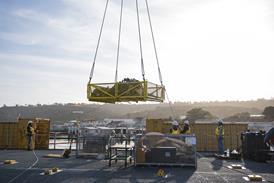Arianespace's chairman says that the company must forge partnerships to maintain its market share
Tim Furniss/PARIS
Arianespace of France and Antrix, the commercial wing of India's Department of Space, signed an agreement on 11 June to pursue a plan to market jointly the Indian Space Research Organisation's Polar Satellite Launch Vehicle (PSLV) and the Ariane 5 to launch auxiliary payloads weighing up to 50kg (110lb).
The companies will establish a common user's manual for auxiliary payloads that will be compatible with both the PSLV's Specific Auxiliary Payload Structure and the Ariane 5's Structure for Auxiliary Payloads.
The agreement reflects the intention of new Arianespace chairman and chief executive Jean-Marie Luton (see box) to form worldwide strategic partnerships with launcher and satellite operators as part of an effort to ensure that his company maintains its market lead against increasing competition, especially from US companies (Flight International, 3-9 June, P52).
Boeing, which operates a commercial Delta fleet and is a lead investor in the Sea Launch venture (Flight International, 17-23 June, P55), is a strategic business partner in the Teledesic satellite system, which will require the launch of over 200 satellites into low Earth orbit. This is just one example of a series of similar US partnerships and Arianespace is keen to follow suit.
An obvious candidate for such a tie-up would be the Alcatel-led Skybridge system, which will compete with the Teledesic and will require the launch of more than 80 satellites. However, Luton says that he is targeting new systems yet to be introduced formally.
"We need to invest in new satellite systems. It is a question of the market," he says, adding that he has received approval from the Arianespace board to proceed in this strategic direction. "It does not necessarily have to be multiple satellite systems, it could be a single satellite, for which we could be a partner and offer a discounted launch as part of the deal."
PURSUING PARTNERSHIPS
Partnerships with other launcher organisations, as in the case of Antrix, will be pursued. Luton has been talking to China with a view to a joint venture launch system. "We are ready to talk to the Chinese and also the Japanese," he says. "Our interest is to have a good range of launchers which can be used by both."
Another potential teaming arrangement, says Luton, could involve the development of a booster tailored for launches of a European navigation satellite system. Single satellites would probably require an Ariane 4 launch, but he says: "Ariane 4 is just too expensive. We need to reduce launch costs." So an Ariane 4 derivative, using components from another launcher, could be developed, Luton suggests.
Arianespace's sales last year were Fr6,563 million ($1,093million), producing a net income of Fr77.4 million. Luton says that, following a launch hiatus since April, seven Ariane 4 launches are planned from August to the end of the year (not including the third Ariane 5 launch, flight 503) . If successful, Ariane 503 will clear the way for the first commercial Ariane 5 launch, flight 504, in January.
Flight 504 and the seven Ariane 4 launches planned by the year-end will have to launch 12 satellites, with two of them - the Afristar and Asiastar - probably flying on the 504. The ability to make seven Ariane 4 launches in four months was demonstrated in 1997, says Luton.
The hiatus in launches was caused mainly by late delivery of customer satellites, a trend that is causing concern for the entire commercial launcher industry, not just Arianespace. "Satellites are just not getting to Kourou," says Luton. "There have been incidents and mishaps-We are doing everything we can to meet the demand and have the capacity and capability to react and provide a reliable service."
Maintaining market share has a lot to do with Arianespace's efforts to tailor its launchers as well as to form partnerships, says Luton. Orbits and inclinations are becoming different, with constellation systems, and Arianespace needs a flexible fleet, he adds.
New, uprated, versions of the Ariane 5 are planned, to increase geostationary transfer orbit (GTO) capability to 11,000kg by 2005 and to make the launcher more attractive to other orbital customers, such as those operating satellite constellations. Production costs must also be reduced, by 10% a year to 2002, says Luton.
He admits it was a mistake to tailor the Ariane fleet for GTO launches primarily and that the company is now paying the price. Given the way in which the market has developed, it was an understandable mistake, but Arianespace's error was perhaps in realising it too late.
To meet the low Earth orbit (LEO) market, Arianespace is already part of the Starsem consortium which promotes the Russian Soyuz launcher, and will be involved in the proposed European Space Agency development of the Vega LEO launch vehicle, which has a target cost of $20 million per launch.
Source: Flight International























